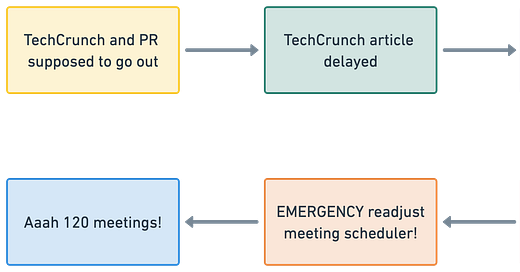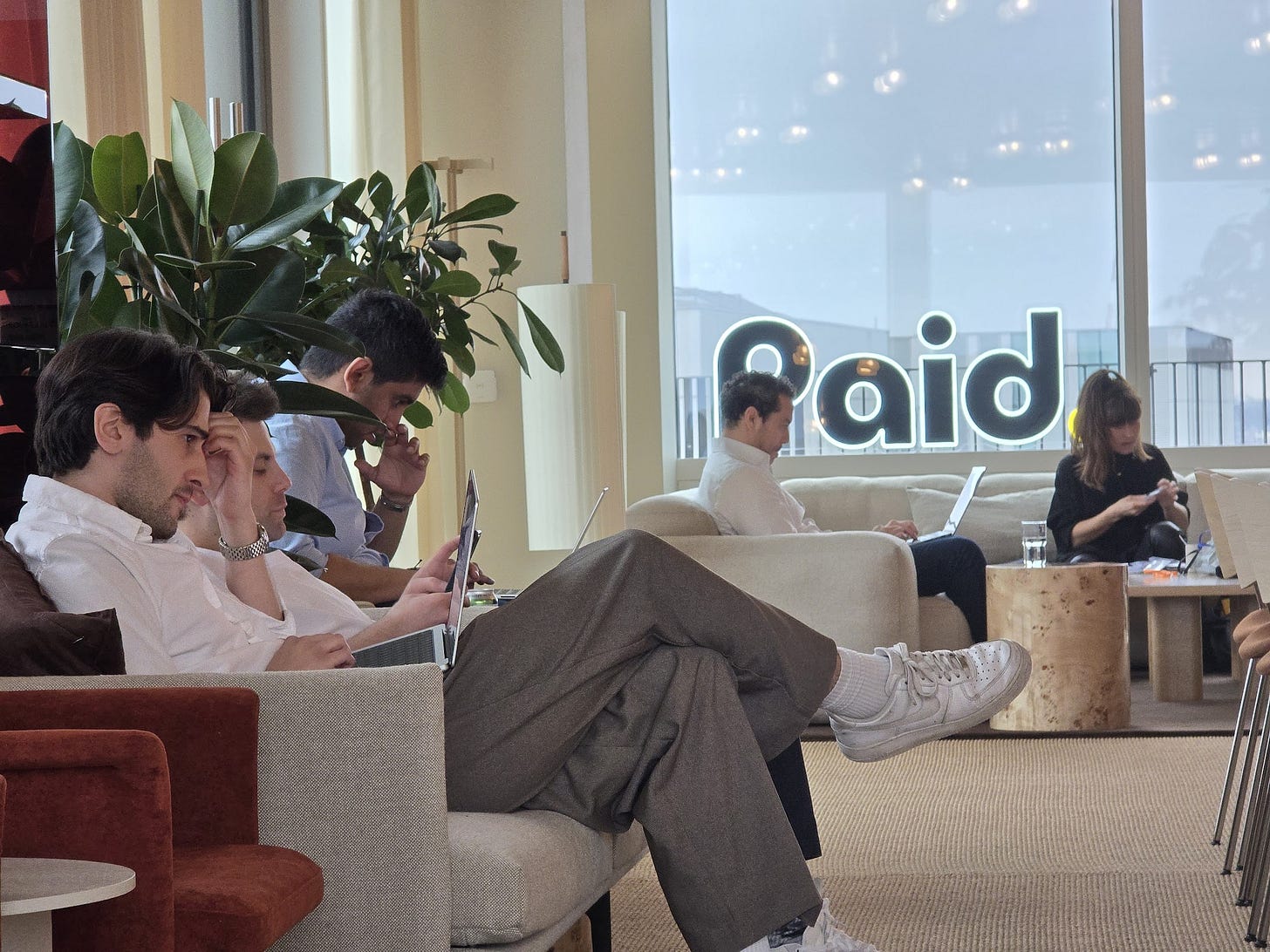Our playbook for launching Paid.ai
We announced when we were ready, generated >1000 signups and the momentum continued for weeks.
So you want to launch a company in 2025? Let me tell you how we did it at Paid, where we raised €10M to revolutionize AI agent monetization.
This isn't your typical "we got covered in TechCrunch and everyone clapped" story - this is my playbook, complete with what worked, what didn't, and what we had to scramble to fix mid-launch.
The plan
We approached our launch as a strategic chip to be played at exactly the right moment. As everyone should.
You only have one chance to launch.
We decided to launch with a party for our investors and several of our customers. We set the date to our March 25th launch party date, and then created clear milestones “working backwards”:
March 25, 2025: Launch party (with actual humans in the same room!)
March 24, 2025: We will have a PR and a TechCrunch article
March 20, 2025: Launch day assets finalized (intro video, images, banners, etc.)
March 17, 2025: Website and brand guidelines completion
February 28, 2025: Friends and investors identified and ready to be invited
February 13-14, 2025: Tour party locales, figure out size of party
February 12, 2025: Begin preparing content (photos, our manifesto)
Our story is simple but powerful: AI agents are transforming software, but there's a massive disconnect in how they're monetized. Traditional SaaS pricing doesn't work for agent-based businesses, and we built Paid to solve this problem.
Our friends and advisors pushed us to be more provocative: "The SaaS model is dead and not coming back." We identified clear "villains" in our story:
Hidden costs (LLMs, credits) that can't be managed
VCs demanding traditional MRR/ARR metrics for non-traditional businesses
Outdated seat-based pricing that makes zero sense for agents
📊 The Launch Process Explained
We organized our launch into five key verticals:
🎨 Brand & Content Development
We prioritized having a clear and relatable manifesto that we can share, that will resonate with people. It went through 4 or 5 iterations before being finalized. We recorded it on the morning before the launch!
30 seconds of pure value prop - a professional intro video, to bridge the gap between the messaging and the product itself (took 3 weeks to produce).
Our animator Rasmus Johan worked fast and we had a video in record time!Brand guidelines and visual assets (to be completed within <2 months)
Strategic Thinking:
Our three core value propositions: Monetization, Margins, and Momentum needed to be communicated consistently everywhere. The manifesto became our north star.
For our video content, we focused on a simple but powerful message: "How do you monetize an AI Agent business? There is no blueprint for how to monetize AI Agents."
What We Deprioritized:
Extensive podcast production pre-launch. Even though we were running with Agent Talk, it’s production value will remain “just OK” for now.
It was also a bit harder to get all of the guests we wanted before we launched - since they weren’t aware of the context behind what we’re doing.“Sales enablement” material and long-form blogs will have to wait. No white papers or one-pagers yet!
🌐 Online Presence
What We Prioritized:
Website completion by March 17, a week before the launch. That’ll give us enough time to work out any bugs. Litebox were super helpful here!
CRM setup - we offloaded this to a contractor who knows how to do this fast!
Social media account creation (LinkedIn, X, Meta)
Launch day assets finished by March 20 so that we can just hit “Go!”
All of our employees know their role during the launch
Day-by-day messaging for launch week and subsequent weeks
Strategic Thinking:
Each founding team member had a unique perspective on why they joined Paid.
We wanted to make sure those were captured in our messaging.
We all think about things differently, and the different perspectives reach the respective networks differently.
What We Deprioritized:
Automated marketing funnels with more than 2 steps.
We decided to have a very simple flow that could drop some people, but wouldn’t overwhelm us or our users. A simple signup form is all we went with.Multi-page website. A one-pager will have to do for now!
📣 PR & Outreach
What We Prioritized:
PR firm engagement (Our investors EQT and Sequoia were super helpful in arranging the PR work)
Direct outreach to TechCrunch to get our story out there
Having all of the press briefing material prepared ahead of time
Podcast outreach strategy (20VC, Training Data-Sequoia, etc.)
Comprehensive Q&A preparation
Strategic Thinking:
We deliberately leaned into our networks (especially Manny’s) to distribute our message. We had specific angles for each podcast and news outlet.
Some examples:
"Why great AI Agents will be about monetization"
"Building the GDP for the AI economy"
"Why AI Agent Monetization is the Next Big Platform Play"
What We Deprioritized:
Broader press outreach. We preferred quality over quantity!
Using a "podcast house" to record podcasts more professionally. Guest quality mattered more.
🎉 Event Planning (March 25 Launch Party)
What We Prioritized:
Venue selection - it had to be tight
Little delightful details (a glowy sign, nice food and drinks, churro stand!)
Demo flow, videos, and exact messaging practiced
A "who's who" guide for the team, so that we could connect faster
Having a photographer (Adam Kang) on-site to capture the event
Creating a little bit of FOMO around us 🙇♂️
Strategic Thinking:
The physical gathering needed to embody our brand values. We wanted a space where natural connections could form between investors and design partners.
We arranged our own demo and launch around our early customer’s products.
We gave them room to demo their wares, interleaved with ours - to keep everything interesting.
We practiced our demo flow during the 2 days before the party to get the flow just right.
What I never got to finish:
Swag/merch (I'm still annoyed about this one - there just wasn’t enough time to create good merch!).
I did get some stickers though.
👥 Engagement & Content Strategy
What We Prioritized:
Building a comprehensive list of friends and investors
Creating "what to say" materials for them, and telling them what we expected of them
Writing personalized posts for founding team members
Detailed hour-by-hour messaging plan for launch week:
Tuesday: TechCrunch article + company announcement
Wednesday: Manifesto video + podcast release
Thursday: Our messaging framework
Friday: Post about how the response to the launch was
Monday: "Vibe Revenue" blog post - it was such a good podcast!
Tuesday: Product preview
Wednesday: Usual podcast release
Strategic Thinking:
We focused on "owning the week" with a carefully orchestrated content strategy.
For our waitlist strategy, we designed a clear approach:
Set clear expectations with "Join the beta" messaging
Plan for a monthly digest email for the entire waitlist
Provide additional documentation to higher-quality leads (“3-4 stars”)
Maintain low barriers to entry for sign-ups, enriching data later
Target building a waitlist of thousands with 10% (500) as high-quality leads
What We Deprioritized:
Community building (pushed to post-launch)
SEO and amplification strategies
Pay-to-play podcast opportunities
🏃♂️ Launch Day: What Actually Happened
For the actual launch execution, we followed these principles:
Pre-preparation is everything: All assets were completed in advance. Launch day was for engaging, not creating!
Coordination timing: All communications were carefully sequenced with the PR release as the trigger.
All hands on deck: Our entire team blocked the launch day for active engagement.
Rapid response: We committed to quick responses to every comment and message.
But here's what actually happened: The PR release got postponed by a day, and everything happened within the same 3 hours.
We still got OVERWHELMED.
Meeting bookings were flooding our calendars while we were preparing for our launch party, and while we were trying to stay on top of our socials.
The response was so big that we had to extend our "break time" before booking a meeting to 7 days to avoid being fully booked on the same day as our TechCrunch article went live.
Even with this adjustment, we were fully booked for the next 2-3 weeks.
Then, we had the party and all of the guests arrive at the same time.
It was fun but it was not ideal.
Our demos went swimmingly however!
Party was excellent though!
📈 The Numbers: Holy Smokes!
The 24 hours of our launch exceeded expectations:
15.8K visitors, 47K views (7,500 on first day, 5,800 on second day)
2,700 new LinkedIn followers, 15,000 impressions
Manny's announcement post: 532,270 impressions, 3,280 reactions, 511 comments, 63 reposts
YouTube: 2,202 views, 14.9 hours watched
Inbound: >650 signups, >140 scheduled meetings
45 attendees at our launch party, with 20 more on a waitlist
We’d reach >1000 signups within a week.
💸 The "Vibe Revenue" Concept
One of our most successful post-launch content pieces was about "vibe revenue" - a term coined by Pat Grady during a conversation with us. It refers to the initial surge of adoption and revenue when launching something new in AI, driven more by excitement than sustainable value creation.
Vibe Revenue - a mirage of AI success
Pat Grady coined the term “vibe revenue” in a recent conversation with us.
This concept resonated deeply because it highlighted a critical challenge in the AI space: the difference between initial excitement and long-term value. We identified three critical elements for sustainable momentum:
Workflow integration - not just features
Expansion - initial results aren't enough
Outcome sharing - don't trust usage metrics alone
🧠 What I learned from our launch
I mean, some of these should be obvious, but still.
Timing trumps speed: Wait to announce until you can capitalize on momentum.
Quality over quantity: Do fewer things exceptionally well.
Personal activation beats mass communication: One-on-one outreach to key supporters creates far more impact. Use your networks!
Vision must match reality: Carefully calibrate your messaging.
Prepare for the "vibe revenue" phase: Acknowledge that initial excitement will happen, but don't be fooled by it.
Messaging cohesion is critical: As our marketing advisor emphasized, "tighten messaging, more consistently harp on the same thing" and avoid "random acts of marketing".
Plan for success: We would use contractors to help get things to a good state. Brand design, website building, videos - these will have to be outsourced. This is not free - the time spent managing contractors was still significant.
Leverage founder networks strategically: Manny's connections were invaluable for amplifying our message.
😬 What I Would Do Differently Next Time
Complete the swag: Physical brand touchpoints matter (yeah, still annoyed).
Assume your launch will go gangbusters. Prepare the nurture!: Have a plan for maintaining engagement with waitlisted companies. We had enough, but we can still do better.
Prepare more post-launch content in advance: Having a content reservoir ready would have helped capitalize on the initial surge.
Better prepare for overwhelming response: We were fully booked for 2-3 weeks - having more capacity for inbound interest would have been valuable.
Create a more structured task tracking system: At some point I had to re-do the whole launch plan, because I was missing a high level overview of the individual tracks. It was in my head, not in an easy-to-follow list.
I ended up with a very simplified checklist in Notion, with a calendar view
This playbook represents our journey, with all its successes and lessons learned.
While all this planning was crucial, being able to adapt on the fly was equally important. Having backup plans is key. No big launch goes perfectly according to plan!
A checklist for surviving a launch in 2025
Finally, here’s a checklist you can follow and use, specifically for the final 48 hours:
👥 Team Readiness
All team members have blocked calendar for launch day
Clear roles assigned (who responds to comments on socials, who handles meeting bookings)
Everyone practiced their elevator pitch and key talking points
Team has access to all final assets and messaging documents
"Who's who" guide distributed to team for networking events
🎨 Content & Assets
Website fully tested and live
PR release approved and scheduled
Social announcement posts drafted for all team members
Launch video finalized and uploaded to all platforms
Screenshots/images prepared for social sharing
Demo flow practiced at least 3 times
🔄 Response Management
Meeting booking buffer time set (suggest 5-7 days as we learned!)
Auto-responders configured for high-volume channels
CRM tags created for tracking launch sources
Template responses prepared for common questions
Prioritization system for inbound requests established
📊 Tracking & Measurement
Analytics tracking confirmed working
Baseline metrics captured (followers, subscribers, etc.)
URL parameters set for different traffic sources
Screenshot tool ready for capturing moments/milestones
Designated person for collecting key stats throughout day
🛡️ Contingency Plans
Backup plan if PR gets delayed
Technical support contact if website issues occur
Alternative messaging if certain angles don't resonate
Capacity plan if response exceeds expectations (it likely will!)
🎯 Post-Launch Momentum
Week 1 content calendar finalized and scheduled
Follow-up plan for key sign-ups and leads
Thank you messages prepared for supporters and amplifiers
Team debrief scheduled for 24-48 hours post-launch
Metrics review planned for 7 days post-launch
Remember - while all this planning was crucial, being able to adapt on the fly was equally important. No launch goes perfectly according to plan, but having this checklist should help ensure that when things inevitably shift, you'll still capture the momentum of your big moment!











